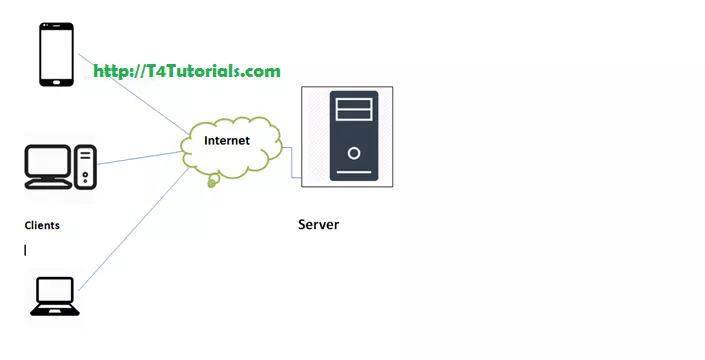Client-server Database Architecture in DBMS
In client-server architecture many clients connected with one server. The server is centerlines.it provides services to all clients. All clients request to the server for different Service. The server displays the results according to the client’s request.
Client/server architecture is a computing model in which the server hosts (computer), send and manages most of the resources and works to be required by the client. In this type of architecture has one or more client computers attached to a central server over a network. This system shares different resources.
Client/server architecture is also called as a networking computing model and client-server network because all the requests and demands are sent over a network.
Working of Client-server Database Architecture in DBMS
Basically client-server model defines how the server provides services to clients Server is a centralized computer that provides services to all attach clients. For example file server, web server, etc. each the basic work of server to provide services to each client. The client can be a laptop computer, tablets, and smartphones, etc. The server has many types of relationship with clients. Many servers have one too many relationships with clients.in one too many relationships many clients connected with one server. When one client wants to communicate with the server. The server may be accepted or rejects the request of clients. When the server computer accepts the request of clients than server maintains a connection according to a defined protocol. The protocol rules over the network.
That must be followed for any network connection. If the one client wants to send an email over the network. It requests the server, the SMTP (the protocol that is SMPT is standing for simple mail transfer protocol that used to transfer a mail over the network. SMTP is a set of commands or commands that check authentication and the transfer of email. When configuring the settings for your e-mail program, you usually need to set the SMTP server to your local Internet Service Provider’s SMTP settings. After all process, the server will transfer e-mail to the desired client.
Another example of a client-server model is online gaming.in online gaming.
Structure of Client-server Database Architecture in DBMS
By using this architecture structure this software is divided into three different tiers:
- Presentation tier
- Logic tier
- Data-tier
Each tier type builds and maintains independently.
1-Presentation tier
This is the first and topmost level of the application n. The basic work of this layer provides user interface .the interface is a graphical user interface. The graphical user interface is an interface that consists of menus, buttons, and icons, etc. The presentation tier presents information related to such work as browsing, sales purchasing, and shopping cart contents. It attaches with other tiers by computing results to the browser/client tier and all other tiers in the network.
2-Logic tier
The logical tier is also known as data access tier and middle tier. It lies between the presentation tier and the data tier.it basically controls the application’s functions by performing processing. The components that build this layer exist on the server, assist the resources sharing these components also define the business rules like different government legal rules, data rules, and different business algorithm .which are designed to keep data structure consistent.
3-Data tier
This is basically the DBMS (database management system) layer. This layer consist of database.it can be used through the business services layer.in this layer, data is stored and retrieved .the responsibility of this layer to keep data consistent and independent.
Providing data its own tier also improves scalability and performance. This layer consists of data access components.
Advantages of Client-server Database Architecture in DBMS
- All the data and resources are controlled by server .im this way all data and resources are very consistent.
- You can easily increase the number of client in this architecture at any time. This all increases the scalability of the network.
- This is very easy to maintain you can easily repair, replace or add clients in this network. the independence of the changes also known as encapsulation.
- This network is very easy to use and it is not complicated.
Disadvantages of Client-server Database Architecture in DBMS
- Traffic is a big problem in this network.
- When you add large numbers of the client with server this network will be more complicated.
- When the server goes down all the clients are not able to send their request. The whole work will be stopped
- The hardware and software are very expensive.
- The client does not have resources for each resource they need to request the server. Because of all resources exit on server



